Unique terrain, rich history, astounding views and a warm, welcoming culture make Ireland a worthy trail-running destination.
By Elinor Fish / Run Wild Retreats – Feb 2018
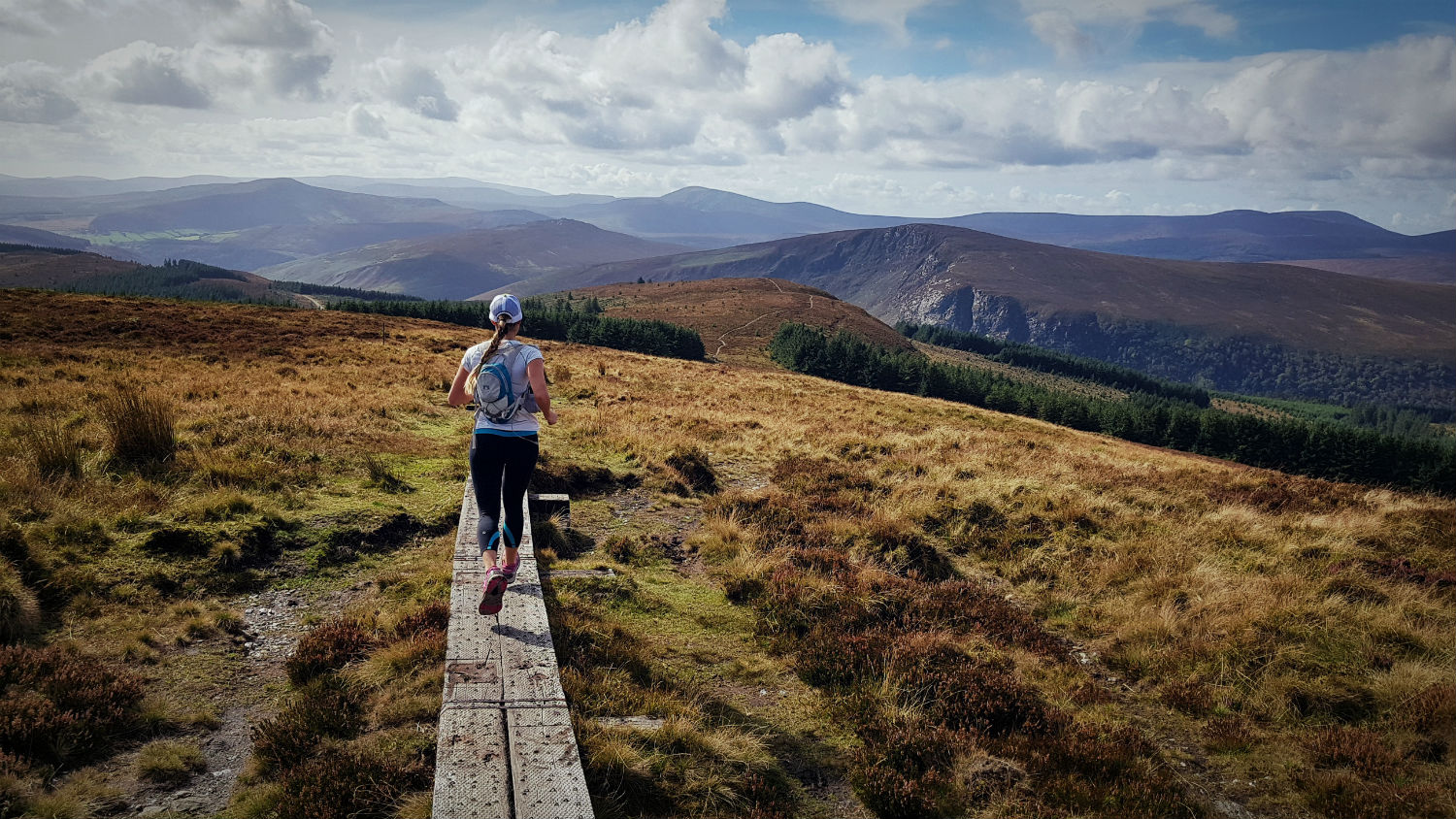
Along the Wicklow Way
Ireland doesn’t have the high mountain ranges, internationally known trail races and huge swaths of raw wilderness that typically attract trail runners. But it does offer unexpected gems that should put it high on any trail runner’s bucket list: historic paths, beautiful national parks, warm and friendly people, a lack of predatory animals and, most importantly, great pubs.
“Ireland’s trail running scene is incredibly friendly and relaxed yet highly competitive,” says Clare Keeley, 41, of Arklow, County Wicklow, a nurse who started trail running five years ago and participates in some of the Irish Mountain Running Association’s local races. “Ireland is so small, so it doesn’t take long to get to know all the regular faces at events. There are trail-running groups around the country with open invitations to join their runs.”
Apart from witnessing natural beauty, trail running in Ireland is a great way to discover remnants of the country’s long and storied history. The country has many historic roadways—mostly closed to motorized travel—such as The Wicklow Way, The Kerry Way and The Burren Way, some sections of which make for great trail running. From stone tombs older than the Giza pyramids to 12th-century Norman Castles, Ireland’s heritage lives on in its landscape.
And while June through September offers the driest, mildest weather, trail running is possible any time of year since temperatures never get particularly hot or cold. Snow is a rarity.
The whole country is the size of the state of Indiana, yet it is comprised of very distinct regions, each with its own culture, culinary specialties and climate. During my visit there last September with my husband Rob and eight-year-old son Reed, I explored three of Ireland’s 32 counties, County Wicklow, County Clare and County Kerry, in search of Ireland’s best trail runs. Here’s what I found.
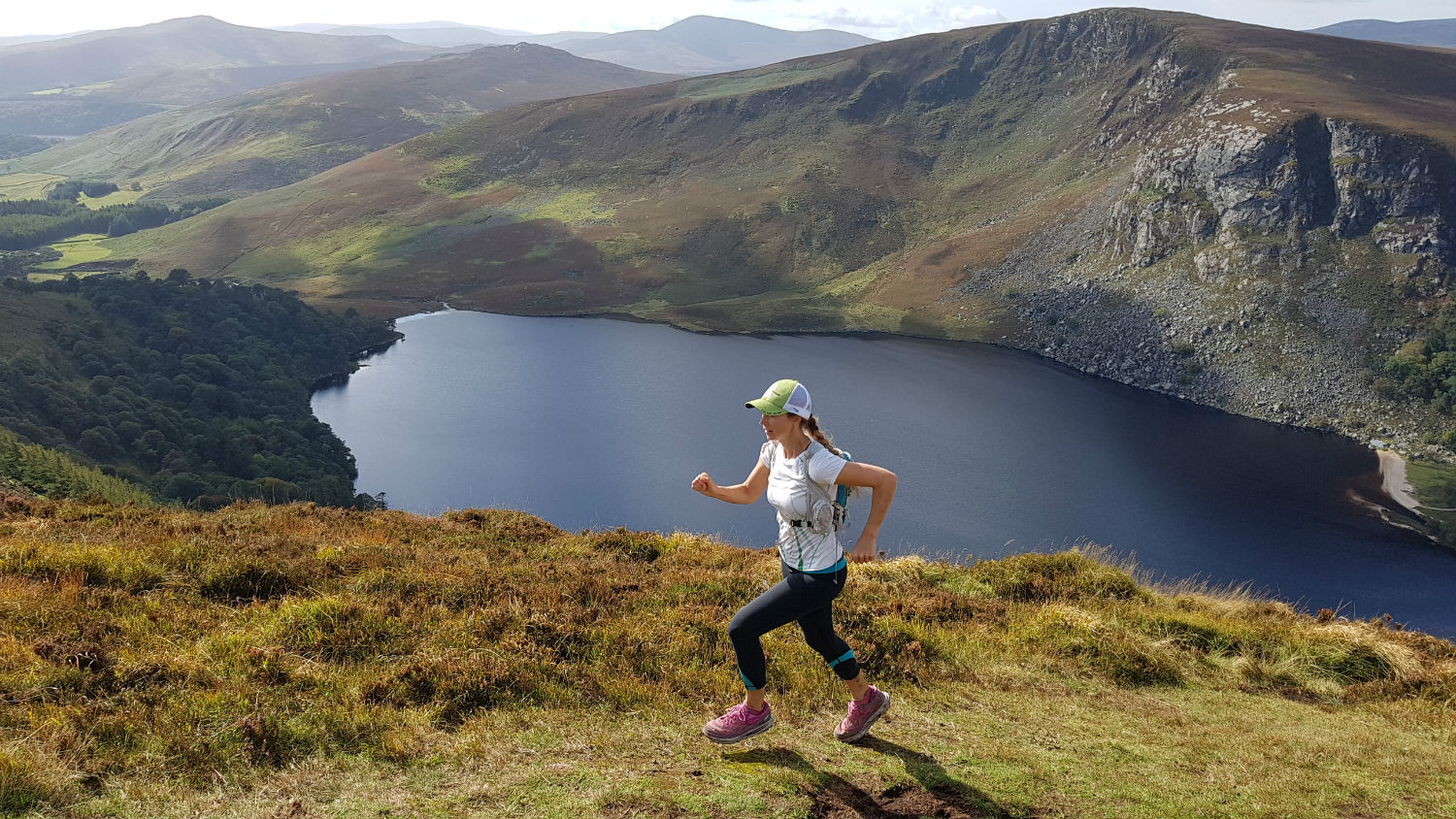
Above Lough Tay: The Guinness Lake!
Wending Through Wicklow
Our first stop in Ireland was County Wicklow, on Ireland’s east coast, less than 50 miles south of downtown Dublin. Frederic Verdier, a French ex-pat who works for Wicklow Tourism and curates Ireland’s best online resource for trail runners (www.TrailRunningIreland.com), offered to join us for a leisurely run along an eight-mile stretch of the Wicklow Way.
Ireland’s notoriously windy roads make just getting to the trailhead a unique adventure. Driving us from the Trooperstown Wood Lodge B&B in the village of Laragh, Fred deftly maneuvered the car along a narrow road that wound through dense hedges. A thick canopy of trees blocked out most of the morning light. Unable to see around the tight corners for oncoming traffic, I kept my eyes downcast and held my breath until we had safely pulled into the trailhead parking area.
It was nearly empty, and surrounded by forest so lush and overgrown I couldn’t see more than 50 yards into the woods. Our run began along a broad, well-worn trail that gradually ascended above treeline, despite being only a few hundred feet above sea level. Near-constant wind and soggy, boggy ground mean that few trees grow here; but brilliant purple heather flourishes.
As we puffed along, I asked Fred when trail running became popular. “Running up hills in Ireland is an ancient thing, mostly done by people running away from the Vikings, the Normans, the English and others,” he said. “Other than that, I’d say it’s very young as a sport, although steadily growing.”
The full Wicklow Way is a 127-kilometer (79 miles) journey through Ireland’s 5,000-year history, including ancient tombs, sites of worship, early Christian settlements, remnants from the days of Vikings and Normans, rebel strongholds, majestic mansions and vestiges of industry.
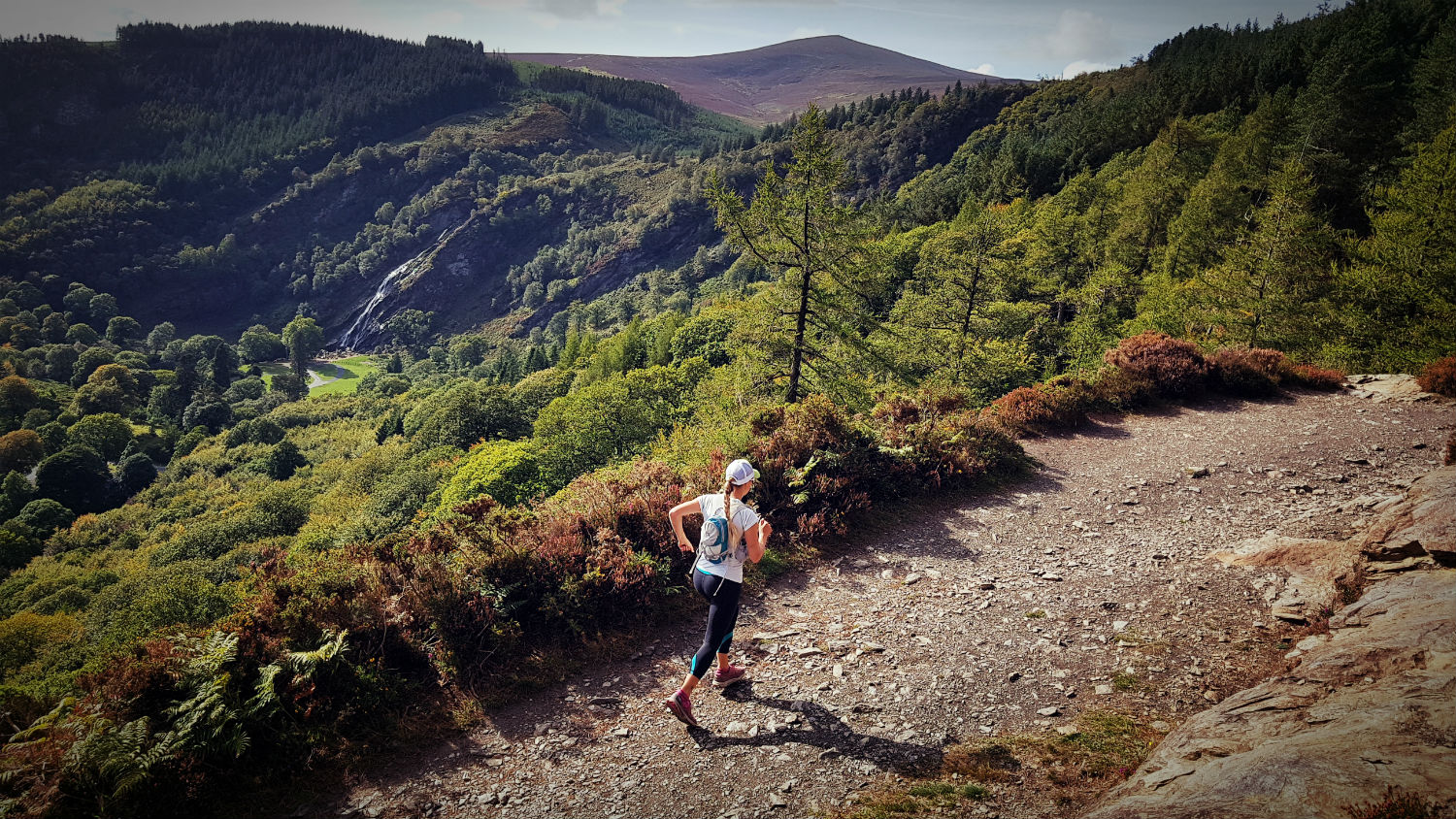
The Wicklow Way with Powerscourt Waterfall and Djouce Mountain as backdrop
“I absolutely love running the Wicklow Way!” says Clare, who finished first-place woman in the 2017 Wicklow Way Race, which gives runners up to 21 hours to run the length of the entire Wicklow Way. “There’s everything from technical sections along Fairy Castle to jumping down boulders, forest tracks, boreens and boardwalks to the open mountain terrain along the shoulder of Djouce Mountain.”
Djouce Mountain is a rounded, bald hilltop covered in shoe-sucking peat bogs. The terrain would be nearly impassable if it weren’t for the miles of narrow boardwalks covered with grippy wire mesh. The peat’s murky runoff is apparently what gives Guinness Lake, home to the Guinness family estate, the blackish hue that inspired creation of the world-famous Irish stout.
After we descended Djouce and re-entered the dark forest, Fred enthusiastically started listing trails I should run the following day. “You’ve got to check out the trails around Glendalough,” he says. “There are easy trails that loop the upper and lower lakes and take you past preserved early medieval monastic settlements dating back to the sixth century, to The Spinc, which is a real ramble.”
Back in the village of Laragh, at the Wicklow Heather Restaurant, we poured over trail maps while digging into bowls of hearty fish soup.
The Wild Atlantic Way
The next day, Rob, Reed and I drove west to the county of Clare, an area known as The Wild Atlantic Way. Within minutes of exiting the expressway, we entered Burren National Park, which at first glance, appeared to be a barren an unremarkable landscape.
I’d heard about The Burren from Rowan McMahon, of Primal Challenges, organizer of the Celtic Traverse stage race held each June. “Running in The Burren is like running through a moonscape because the ground is completely covered in smooth limestone rock,” he says. The Burren (which comes from an Irish word “boíreann” meaning a rocky place) is a 155-square-mile expanse of rock-covered ground, which offers fertile growing conditions for a variety of plant species found nowhere else in the country.
The Burren Way walking trail snakes through the park, though it is more of a dirt road than a trail. What it lacks in views it makes up for in periodic curiosities in the form of ancient dolmens, small above-ground tombs made from large rock slabs, dating back to sometime around 4,200 and 2,900 B.C.
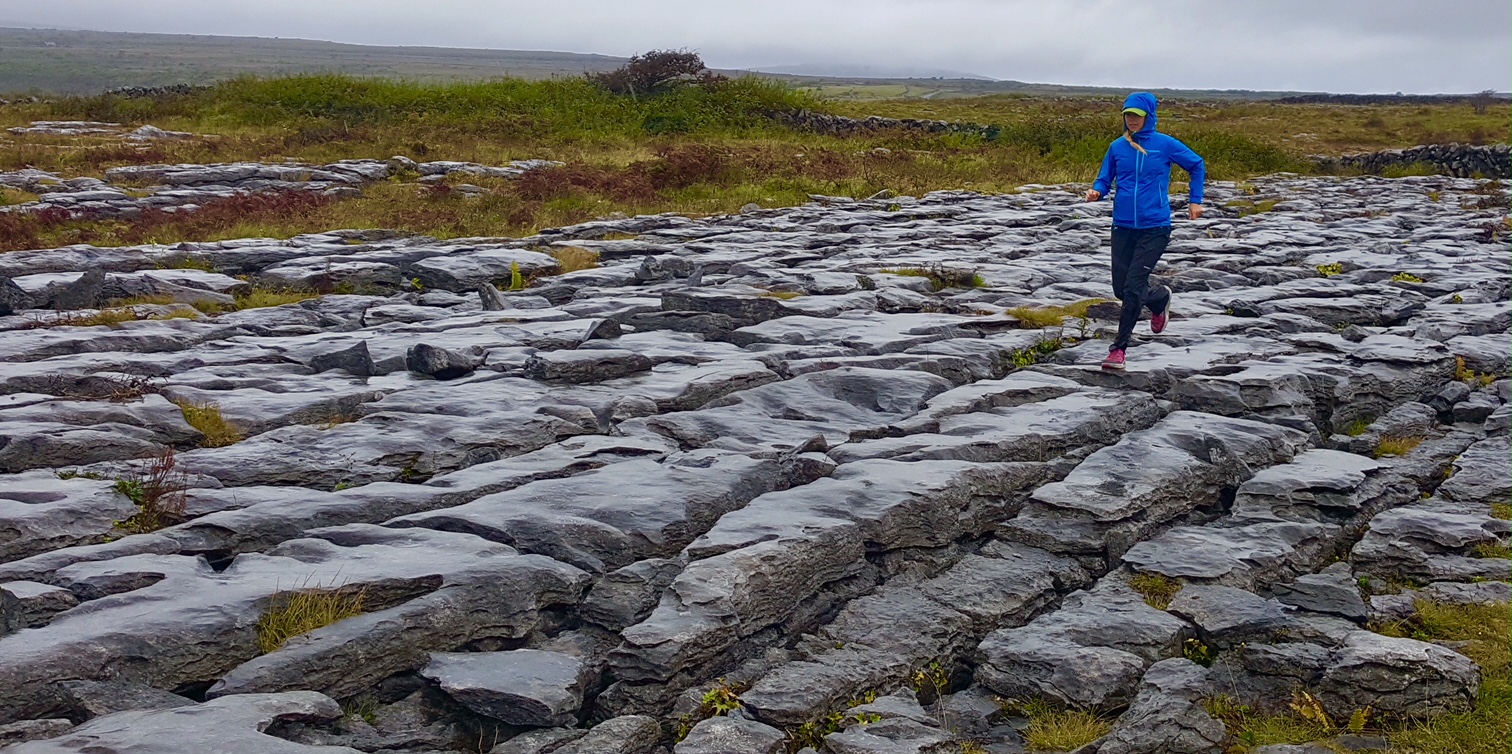
The Burren’s swaths of horizontal limestone make for a challenging running surface. Photo credit: www.runwildretreats.com
Increasingly strong sideways-blowing wind and rain dampened my motivation to run much of The Burren Way, so I hopped into the car with Rob and Reed to catch a ride north to the coastal village of Ballyvaughn.
As we drove the coastal highway from Balleyvaughn to Fanore, the skies cleared, which revived my spirits enough to scout out part of the nine-mile Black Head Loop trail. Despite the trail’s glowing recommendations in local hiking guide books, the trail was hard to find. The only signage we found were tiny four-inch trail signs on knee-high posts obscured by long grass.
The Black Head Loop trail is comprised of a mix of grassy lanes, dirt roads (called “tracks”) and mountain paths at Caher Valley and Gleninagh Mountain. At certain times of year, wildflowers abound, though the thick vegetation chokes the trail, making it challenging to follow in parts. It’s worth the bushwack, however, to soak in the ocean views while contouring the grassy slope of Ceann Boirne, a point that juts out into Galway Bay, offering ocean views that were the highlight of my day.
I was ravenous by the time I met the boys at the trail’s end in Fanore Beach, a popular spot on The Wild Atlantic Way coastal highway. Stepping into the historic O’Donohue’s Pub, we relished the heat of the log fire burning in the hearth. We huddled around a rickety wooden table that looked about as old as the dusty antique farm relics tacked to the pub’s walls and ceiling.
As you do in Ireland, we ordered a bucket of local, fresh-caught mussels drenched in garlic butter. Their plump texture and sea-salty taste went perfectly with our Guinness pints, satisfying not only our hunger, but also my depleted muscles’ craving for salt and carbohydrates.
The next morning, in an effort to beat the crowds at the Cliffs of Moher, I hopped on The Cliffs of Moher Coastal Walk, a spectacular seven-mile hiking trail from the village of Liscannor to the village of Doolin, contouring along the edge of the famous 700-foot-high cliffs.
Moher is Gaelic for ruined fort, though the fort for which these cliffs are named was built 2,000 years ago and is long since gone. Now the area is home to colonies of puffins, kittiwakes, fulmars, wild goats and badgers, while in the summer months, whale sharks swim by in the sea far below.
After finishing my run in Doolin, I welcome the opportunity to escape the relentless, lip-chapping wind and hopped in the car for the three-and-a-half-hour drive south to Killarney in County Kerry.
Killarney National Park
When we arrived at The Lake Hotel, just outside the town of Killarney on the shores of Lough Leane, the hotel owner, Niall Huggard, greeted us warmly. His family has operated The Lake Hotel for over 100 years. Upon learning I had come to trail run, he enthusiastically beckoned me to take a seat at the concierge desk, and whipped out a highlighter and stack of trail maps.
“Killarney National Park is about 26,000 acres, but the landscape is incredibly diverse and there are trails everywhere!” said Niall. “McGillycuddy’s Reeks is Ireland’s highest mountain range, and while there are trails there, they are quite challenging and … can be a bit tough to follow because not a lot of people tread on it. You’d best go with someone who knows the trails well.”
However, it turns out that’s easier said than done. I reached out to another local who could perhaps tell me where to find some local trail runners. “There aren’t really trail running groups around here, though lots of people road run and roughly 20 percent of those people run trails,” says Killarney resident Oliver Kirwan, director of the Quest Adventure Series, one-day multisport races around County Kerry that attract upwards of 2,000 participants each.
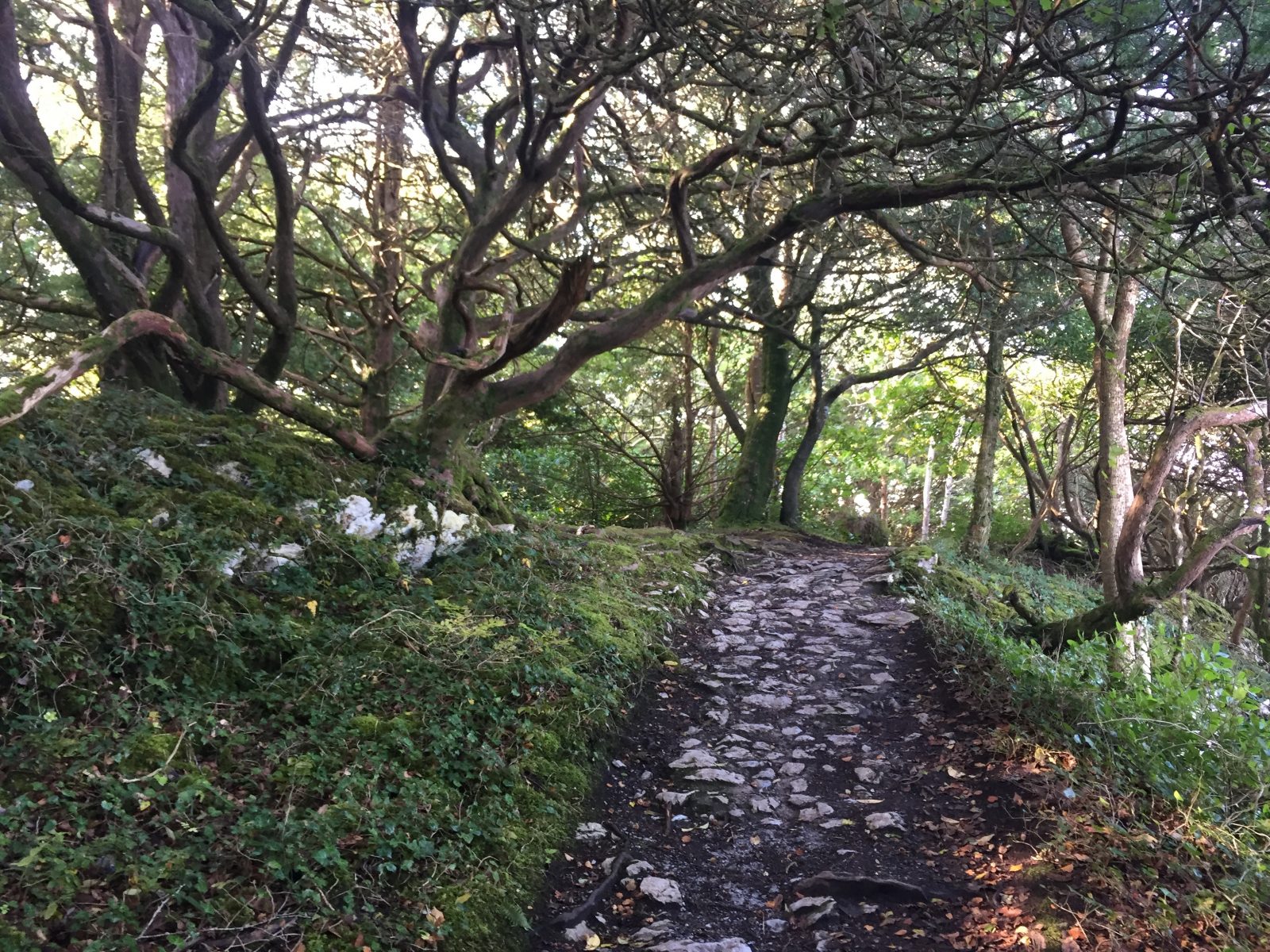
A section of the Kerry Way called Old Kenmare Road is a spectacular stretch of trail that climbs into the Killarney Uplands, where you can see fantastic views and few people. Photo credit: www.runwildretreats.com
So taking Niall’s advice, I had Rob drop me off at Galway’s Bridge in Killarney National Park for a nine-mile point-to-point run along a section of The Kerry Way through Enskamucky Glen, called Old Kenmare Road. The fern-draped trail wove past a series of cascading waterfalls, below low-hanging tree branches. The tunnel of lush greenery felt like something out of a fairy tale.
I emerged from the glen into an open, treeless expanse known as the Killarney Uplands, a multi-colored patchwork of purple heather, red lichens and bunches of brown and green grasses. The foliage formed a tapestry that seemed to constantly change hues as the clouds floating overhead filtered the sun’s rays at various angles. A short side trail offered the extra challenge of summiting Torc Mountain (1,755 feet), which rewarded me with amazing views over Killarney National Park.
Past Torc Mountain, Old Kenmare Road widened into a descending doubletrack that spilt unexpectedly onto the manicured lawn of Muckross House, a pristine Victorian mansion. One last flat, relaxing mile brought me through the woods, past the crumbling stone ruins of a 15th-century abbey, and back to The Lake Hotel.
When I asked each of my new-found Irish running friends the one thing visiting trail runners should know, their sentiments were all very similar: “Reach out to the local running community; the Irish love to talk and are great fun to run with, and that includes sharing a pint of Guinness afterwards.” I certainly found that to be true.
Trail Running in Ireland Resources
WHERE TO STAY
Wicklow Heather Restaurant and Accommodation
Laragh, County Wicklow
The Wicklow Heather and Trooperstown Wood Lodge bed and breakfast share the same owner and are both located in Laragh, a perfectly situated basecamp for your time exploring the Wicklow Mountains.
www.wicklowheather.ie
The Lake Hotel
Killarney, County Kerry
This family-run hotel was originally built in the 1820’s and has been welcoming guests from around the world ever since. It’s location on Lough Leane means you’re away from the tourist hoards and right on the edge of Killarney National Park.
www.lakehotelkillarney.ie
The Falls Hotel & Spa
Ennistymon, County Clare
You’ll be perfectly situated to explore the Wild Atlantic Way and The Burren when you stay here, plus the pool and spa are great post-run recovery and relaxation.
www.fallshotel.ie
About the Author:
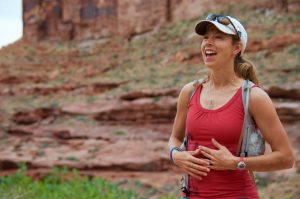 Elinor Fish is the CEO and founder of Run Wild Retreats and will be hosting her first retreat in Ireland in September 2018. She has worked in the travel, tourism and running industries since 1999. The Canadian ex-pat, who now calls Colorado home, has long been an avid trail runner, writer and champion for women’s trail running. She spent four years as the managing editor of Trail Runner magazine, during which she founded Run Wild Retreats + Wellness in 2010. After witnessing the positive impact those early retreats had on the participants, Elinor reached out to her extensive network of contacts in the global running and travel industries to start offering more running tours in some of the world’s best trail-running destinations.
Elinor Fish is the CEO and founder of Run Wild Retreats and will be hosting her first retreat in Ireland in September 2018. She has worked in the travel, tourism and running industries since 1999. The Canadian ex-pat, who now calls Colorado home, has long been an avid trail runner, writer and champion for women’s trail running. She spent four years as the managing editor of Trail Runner magazine, during which she founded Run Wild Retreats + Wellness in 2010. After witnessing the positive impact those early retreats had on the participants, Elinor reached out to her extensive network of contacts in the global running and travel industries to start offering more running tours in some of the world’s best trail-running destinations.
Ireland Trail Running + Wellness Retreat for Women
September 15 – 21, 2019
Run the most scenic sections of the Emerald Isle’s most famous trails such as the Wicklow Way, The Wild Atlantic Way and Kerry Way in Killarney National Park. We’ll see some of the most gorgeous lakes, seaside cliffs and waterfalls Ireland has to offer during this women’s running retreat that is ideal for first-time trail runners.
For more info: https://runwildretreats.com/ireland-trail-running-retreat



